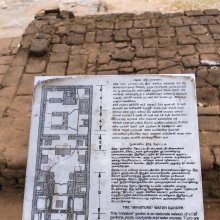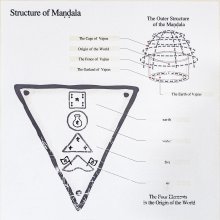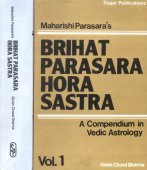Five Elements: 2 definitions
Introduction:
Five Elements means something in Buddhism, Pali, Hinduism, Sanskrit. If you want to know the exact meaning, history, etymology or English translation of this term then check out the descriptions on this page. Add your comment or reference to a book if you want to contribute to this summary article.
Images (photo gallery)
In Hinduism
Yoga (school of philosophy)
Source: ORA: Amanaska (king of all yogas): A Critical Edition and Annotated Translation by Jason BirchThe Five Elements are denoted by the Sanskrit term Pañcabhūta, according to the Amanaska Yoga treatise dealing with meditation, absorption, yogic powers and liberation.—Accordingly, as Īśvara says to Vāmadeva: “[...] [Now], I will teach the practice of that, which produces absorption. [...] Having abandoned the thought that the universe exists of five elements (pañcabhūta); that the body consists of five elements; and that everything consists of the elements, cultivate the thought, ‘[everything consisting of the elements] does not exist’. [...]”.

Yoga is originally considered a branch of Hindu philosophy (astika), but both ancient and modern Yoga combine the physical, mental and spiritual. Yoga teaches various physical techniques also known as āsanas (postures), used for various purposes (eg., meditation, contemplation, relaxation).
In Buddhism
General definition (in Buddhism)
Source: Wisdom Library: Dharma-samgrahaFive Elements:—A technical term in Buddhism corresponding to the Sanskrit mahābhūta defined in the Dharma-saṃgraha (section 39):
- Earth (pṛthvī),
- Water (āpas),
- Fire (tejas),
- Wind (vāyu),
- Space (ākāśa).
The Dharma-samgraha (Dharmasangraha) is an extensive glossary of Buddhist technical terms in Sanskrit (e.g., ‘five elements’). The work is attributed to Nagarguna who lived around the 2nd century A.D.
See also (Relevant definitions)
Full-text (+212): Pancabhuta, Pancabhautika, Pancatva, Pancata, Bhutamaya, Pancatatvem, Pancikrita, Pancatanmatra, Pancatmaka, Pancabhutatman, Arthaprakriti, Pancatatva, Bhautika, Pancavastha, Karya, Bija, Bhuta, Pancadhatu, Bhutagrama, Pancabhutem.
Relevant text
Search found 151 books and stories containing Five Elements; (plurals include: Five Elementses). You can also click to the full overview containing English textual excerpts. Below are direct links for the most relevant articles:
Animal Kingdom (Tiryak) in Epics (by Saranya P.S)
Vaisheshika-sutra with Commentary (by Nandalal Sinha)
Sūtra 4.2.2 (Body is not a compound of five elements) < [Chapter 2 - Of Tangible Atomic Products]
Sūtra 8.2.4 (Sūtra IV.ii.2, re-called) < [Chapter 2 - Of Doubly Presentative Cognition]
Sūtra 4.2.4 (Conjunction of various atoms, not denied) < [Chapter 2 - Of Tangible Atomic Products]
Taittiriya Upanishad Bhashya Vartika (by R. Balasubramanian)
Verse 2.154 < [Book 2 - Brahmavallī]
Verse 1.128 < [Book 1 - Śīkṣāvallī]
Verse 2.402 < [Book 2 - Brahmavallī]
Mahabharata (English) (by Kisari Mohan Ganguli)
Section CLXXXIV < [Mokshadharma Parva]
Section V < [Jambukhanda Nirmana Parva]
Section CLXXXVII < [Mokshadharma Parva]
Samkhya thoughts in the Mahabharata (by Shini M.V.)
The creation of Mahābhūtas (five main elements) < [Chapter 4 - Sāṃkhya thoughts in the Śānti-parva of Mahābhārata]
The Mahābhūtas (five main elements)—Introduction < [Chapter 4 - Sāṃkhya thoughts in the Śānti-parva of Mahābhārata]
Yājñavalkya king Janaka Saṃvāda < [Chapter 3 - The Philosophical Tenets in the Śānti-parva]
Siddhanta Sangraha of Sri Sailacharya (by E. Sowmya Narayanan)
Related products


